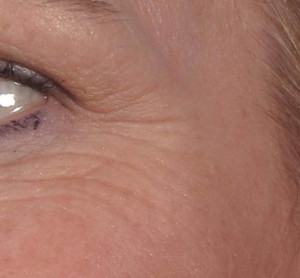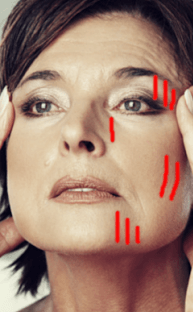Posts
How to get rid of crow’s feet
in Botox and fillers, Wrinkles/by drkotlusCrow’s feet arise from repeated expression
“Crow’s feet” are the creases that radiate outward from the outer corners of your eyes when you smile or squint. They begin to show up for most people in the mid 30’s to early 40’s. They are thought to convey sincerity when you smile (see this video about the SQUINCH by photographer Peter Hurley). The crow’s lines can make you look more photogenic, but if you have too many or they are too deep, they make you look older.

“Crow’s Feet”
How do I get rid of them?
STEP 1 – PREVENTION
Use a broad-spectrum sunscreen of at least SPF 30 and preferably a mechanical blocking agent like zinc oxide. Even while you are driving, your face is exposed to damaging UV radiation that causes aging signs and wrinkles. Other ways to prevent these lines from forming or worsening, use scientifically-proven topical creams like a prescription-strength retinol and a vitamin C (L-ascorbic acid). I don’t recommend that you stop smiling in order to prevent smile lines. You may look younger, but you will lead a less happy life!
STEP 2 – TARGETED MUSCLE RELAXATION
Botulinum toxin type A (Botox, Dysport, Xeomin) are liquid protein injections that selectively relax the muscles that create the crow’s lines. An expert injector can do wonders by placing small amounts of Botox in just the right places. Botox done well looks natural and gives your eyes a younger glow.
STEP 3 – SKIN RESURFACING
Lasers (fractional CO2 and erbium) and chemical peels (glycolic, TCA, phenol) will remove the outer skin layers leaving space for newer, smoother skin to take over. In the case of crow’s feet, if you continue to crease with repeated expressions, the lines will eventually return. A combination of resurfacing with Botox as maintenance will provide the longest-lasting results.
What about fillers like Juvederm or Restylane?
Fillers have a limited role in treating crow’s lines but can be helpful in smoothing very deep, fixed creases. Dermal fillers can also stiffen and plump the skin to limit the amount of folding and creasing that occurs when you squint.
What about eye lift surgery?
A lower or upper eyelid lift may somewhat reduce crow’s feet but is not a good choice if your primary target is expression lines. Surgery is better for heavy upper eyelid skin or lower eyelid bags.
Does sleeping on your side cause wrinkles ?
in Wrinkles/by drkotlusSleep lines are wrinkles created while you sleep
Wrinkles and creases can develop during sleep, depending on the interaction between your face and the pillow. These sleep lines can be noticed as vertical creases under your eyebrows, next to your nose, and on your chin. Back sleepers are probably less likely to develop sleep lines than stomach sleepers. So why do they call it beauty sleep?

Where vertical sleep lines occur (in red)
Does it matter which side you sleep on?
In 2013, I published my research on the relationship between sleep position and facial aging in the peer-reviewed Dermatologic Surgery Journal. My team collected photographs of 100 women who came to me for consultations for facial aging (seeking Botox, eyelid lifts, facelifts, filler injections, etc). We also surveyed these women and asked which side they preferred while sleeping. These photos were split vertically down the middle and the sides were randomly flipped using photoshop. An independent observer was then asked to rate which side of each subject’s face looked older and had more wrinkles. The statistics showed there was no association between the side you mostly sleep on and the side of your face that looks older (is droopier and has more wrinkles). So, while sleeping does cause sleep lines, the side you prefer to sleep on doesn’t appear to develop more wrinkles than your non-preferred side.
Driving a car causes wrinkles on the left side of your face
A majority of the women photographed in the study had more wrinkles and droopiness on the left side of their faces, independent of the side they sleep on. The most likely explanation is that driving causes more UV exposure on the left side, which is also the reason that sun-induced skin cancers are more common on the left side of the face. Sun damage is a more significant and dangerous cause of facial aging than sleep position.
Should you use an anti-wrinkle sleep pillow?
There is little evidence supporting the claim that a special pillow prevents wrinkles. Anti-wrinkle pillows are often promoted as being able to relieve facial pressure points by changing the traditional pillow shape. Others claim to nourish the skin with special fabrics. My study indicates that it is more important to be diligent about wearing a broad-spectrum sunscreen, even when driving. Daily, high quality sunblock should be the primary foundation of your anti-aging strategy. Sleep should be refreshing and restful, so my professional advice is not to worry about sleep wrinkles – worry about awake wrinkles.
Interesting links
Here are some interesting links for you! Enjoy your stay :)Pages
- 5 Steps to Looking Younger
- About
- After Botox/Dysport: “Spock Brow”/Over-arched Brow
- Asian Double Eyelid Lift Surgery in NYC
- Asymmetric Eyelids
- Before and After Portfolio
- Before/After Cosmetic Oculoplastic Surgery
- Blepharoplasty in NYC with an oculoplastic surgeon
- Books
- Botox and Dysport in NYC with an oculoplastic surgeon
- Botox/Dysport/Xeomin
- Brow Lift
- Brow lifts
- Brow Ptosis
- Cannula Tear Trough Under-Eye Filler best for Eye Bags NYC
- Canthopexy and Canthoplasty
- Cheek Redefining
- Chemosis
- consent- biopsy
- consent- blepharoplasty
- consent- brow lift
- consent- chalazion
- consent- cosmetic injection
- consent- double eyelid
- consent- eyelid ptosis
- consent- facelift
- consent- facial implant
- consent- filler dissolving enzyme
- consent- laser or chemical skin peel
- consent- liposuction
- consent- pronox
- consent- revision surgery
- consent- sculptra
- consent- surgery chaperone
- consent- thread lift
- Contact
- Cosmetic Eyelid Surgery Guide
- COVID-19 Measures
- Crow’s Feet
- Dark Circles and Eye Bags
- Double Eyelid Surgery Guide
- Dr. Kotlus Blog
- Droopy Eyelid Ptosis Surgery
- Eye Bags and Dark Circles Treatments
- Eyebrows
- Eyelid Conditions
- Eyelid Procedure Affects
- Eyelid Ptosis Repair
- Eyelid Retraction
- Eyelid Revision Surgery
- Eyelid Skin Fat Deposits
- Eyelid Veins
- Facials
- Fat Transfer, Fat Grafting
- Festoons
- Festoons and Malar Bags
- Glabellar Furrows
- Hollow Under-Eyes
- Home: Dr. Kotlus NYC Oculoplastic Surgeon | Blepharoplasty | Eye fillers
- Lacrimal Gland Prolapse
- Lateral Canthal Blunting
- Lateral Canthal Rounding
- Lectures and Presentations
- Lid Ptosis
- Lip Enhancement
- Liposuction
- Loose Lower Eyelid Skin
- Loss of Eyelid Skin Pigment
- Lower Blepharoplasty (Lower Eyelid Lift)
- Lower Eyelid Bags
- Lower Eyelid Conditions
- Lower Eyelid Fat Pad Reduction/Repositioning
- Lower Eyelid Skin Pinch
- Lower Eyelid Skin Resurfacing
- Lumps/Irregularities
- Necklift and Facelift NYC
- Nose
- Orbicularis Oculi Muscle Tightening
- Other Eyelid Concerns
- Patient Forms
- Patient Reviews
- Pause and Reverse: How to Look Younger Than Your Age With or Without Cosmetic Surgery
- PDO Thread Lift NYC
- Privacy Policy
- Procedures
- Research and Publications
- Residual Fat After Blepharoplasty
- Soof Lift
- Superior Sulcus
- Tame Your Eye Bags and Dark Circles
- Thank you for requesting your NY Thread Lift Consultation
- Transverse Brow Furrows
- Treatment of Chemosis
- Treatment: Lacrimal Gland Suspension (Sagging Tear Gland)
- Treatment: Botox “Spock Brow”
- Treatment: Eyelid Droop After Botulinum Toxin (Botox, Dysport, Xeomin)
- Treatment: Eyelids
- Treatment: Fat Pouches After Eyelid Lift
- Treatment: Festoons
- Treatment: Lower Eyelid Retraction
- Treatment: Lumps After Fillers
- Treatment: Superior Sulcus (Upper Eyelid Hollowing)
- Treatment: Tyndall Effect
- Treatments: Brow
- Treatments: Brow and Forehead Wrinkles
- Treatments: Crow’s Feet
- Treatments: Hollow Lower Eyelid/Tear Trough
- Treatments: Lower Eyelids
- Treatments: Under-Eye Dark Circles
- Treatments: Upper Eyelid
- Tyndall Effect: Blue Discoloration After Hyaluronic Filler
- Under-Eye Dark Circles
- Upper Blepharoplasty (Upper Eyelid Lift)
- Upper Dermatochalasis
- Upper East Side Manhattan Location | NYC Cosmetic Eyelid Plastic Surgeon
- Upper Eyelid Conditions
- Upper Eyelid Lift NYC
- Upper Eyelid Treatments
- Upper Steatoblepharon
- Wrinkle Treatment Fillers | Botox | Laser | Microneedling NY
- Younger Podcast: Expert Advice on How to Look Younger and Live Longer
- 雙眼皮手術頁
